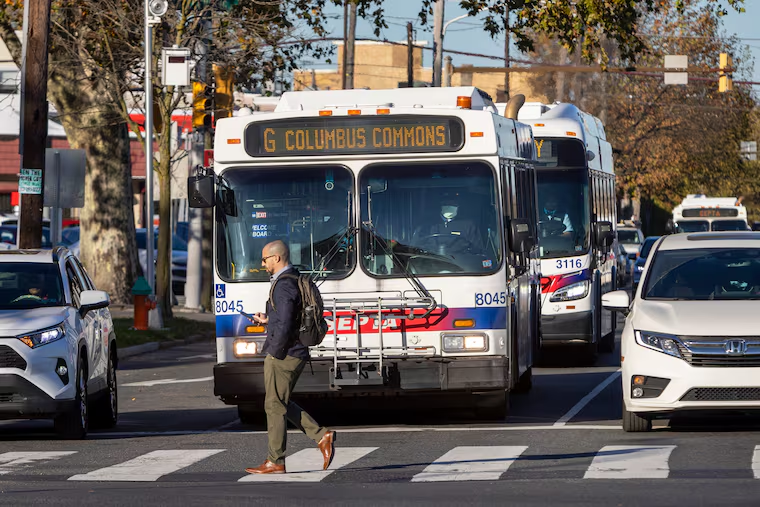City Council and concerned riders pepper SEPTA with criticism, questions on bus route changes
SEPTA says bus ridership dropped more than 13% from 2013 to 2019, before the pandemic — a trend found in other cities.

City Council members and state lawmakers questioned SEPTA officials and dozens of Philadelphians voiced displeasure with the transit agency’s proposed redesign of bus routes Monday, with many suggesting adjustments in granular detail.
The five-hour virtual hearing by Council’s transportation committee showed the extent to which the planned overhaul has roiled much of the city and how it is breaking through as a political issue ahead of the mayoral primary in May.
“You have to be culturally competent in this process,” Councilmember Katherine Gilmore-Richardson said. She noted a lack of diversity on the SEPTA team holding a community open house at a church in Overbrook Farms — and no chairs initially for the many senior citizens who attended.
“I know that it was not intentional, but it’s because there are people on the team and or on the consultant team that don’t understand all the diversity of cultures represented in this city,” Gilmore-Richardson said.
» READ MORE: SEPTA bus riders want faster service, but many hate how their routes could change
SEPTA promises better outreach
SEPTA officials acknowledged they could do better at public outreach, including coordinating with Council members on the best locations for meetings and the way people prefer to get information.
But they also said the bus system must become faster and more reliable to attract more riders.
“The simple fact is that the bus network as configured is not sustainable,” said Leslie S. Richards, SEPTA’s CEO and general manager. “We can make targeted changes, together, on our own terms, now … Or we can face the certainty in several years of being forced to make service cuts.”
That reckoning could begin as soon as 2025, when federal COVID aid is projected to run out, she said.
» READ MORE: Roxborough is the epicenter of dissent for SEPTA’s bus overhaul
SEPTA is making the first comprehensive review of its bus routes since 1964, when the transit authority was created. Over six decades, land-use patterns changed, traffic grew, and the ways people use transit have expanded beyond commuting, but the bus network has changed little, Richards said.
“It was conceived in a different time and has not kept pace,” she said.
Dan Nemiroff, the bus redesign project manager for SEPTA, who answered questions alongside Richards, said he found the criticism and questions constructive.
SEPTA is making revisions to its draft plan, released in October, and is planning another round of public meetings when it releases the next version in March. Route changes would not be implemented until fall 2024.
“We adopted a standard format for the open houses, and it didn’t quite work out,” Nemiroff said in an interview. “We want to be more flexible and less formal.”
Councilmember Kenyatta Johnson, the chairman of the transportation committee, scheduled the hearing after he and colleagues heard a torrent of complaints and questions from constituents since the first draft was released.
“I know we have one of the greatest transportation systems here in the country,” Johnson said. “However, we just want to make sure that the public’s issues and concerns as well as members of Council’s issues and concerns are addressed.”
Fewer, faster bus routes
SEPTA rolled out proposed changes in October, with 99 bus routes, down from 125 currently.
Routes were drawn to use fewer streets and keep buses on arterial roads as much as possible, and many routes were straightened. There would be shorter wait times to catch a bus on routes with robust ridership and the potential to attract new riders. The plan envisions relying on more transfers between bus routes and onto subways.
In the draft, there are 44 high-frequency routes, defined as having scheduled times between buses of 15 minutes or less. Currently, there are 33. The most frequent buses would run from 6 a.m. to 9 p.m., seven days a week.
Bus rider Lisa Hastings testified that SEPTA “continues to relegate the general public to only a reactive role, rather than one including them in the planning process so their insights [were] included from the start.”
She said the bus routes in the city may be old but aren’t outdated. “They are the backbone of transportation in the city,” she said.
Though the majority of the discussion was critical, there was a vein of support for what SEPTA is aiming to achieve and requests for city government to do more itself to help improve public transit — by fighting street-parking abuses, establishing more bus-only lanes, and building bus shelters, for example.
“SEPTA can’t change street layouts; they can’t do parking enforcement,” Alexander Milone of Point Breeze said. Cities such as New York and Chicago don’t tolerate the parking chaos that Philadelphia does and “we need to get real about it,” he added.
“When cars park illegally at intersections, buses can’t make turns,” Milone said. “I can’t count the number of times I’ve been on a bus that literally stops in the middle of a route because someone parks in the middle of the intersection.”
Nick Zuwiala-Rogers, transportation programs director for the Clean Air Council, spoke in support of SEPTA’s efforts. He also said the city should kick in more money for SEPTA operations.
“Currently the city of Philadelphia provides one of the lowest local funding contributions for public transit,” said Zuwiala-Rogers, who also is a member of the board of Transit Forward Philadelphia. “Despite being among the top 10 cities in the United States in generated revenue, we provide less local support than peer cities.”